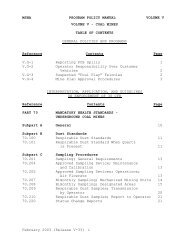MSHA HANDBOOK SERIES - PH13-V-1 - Mine Safety and Health ...
MSHA HANDBOOK SERIES - PH13-V-1 - Mine Safety and Health ...
MSHA HANDBOOK SERIES - PH13-V-1 - Mine Safety and Health ...
You also want an ePaper? Increase the reach of your titles
YUMPU automatically turns print PDFs into web optimized ePapers that Google loves.
GENERAL COAL MINE INSPECTION PROCEDURES AND<br />
INSPECTION TRACKING SYSTEM <strong>HANDBOOK</strong> CHAPTER 4<br />
deteriorated or damaged condition, obtain the name of the explosives supplier. In<br />
addition, determine that any deteriorated or damaged explosives encountered are<br />
being h<strong>and</strong>led <strong>and</strong> disposed of properly by the mine operator.<br />
Consider degraded explosives as non-permissible, as they can be unstable <strong>and</strong><br />
unexpectedly detonate if mish<strong>and</strong>led. If degraded explosives are used, a misfire,<br />
hang-fire, or fire can occur. Therefore, special precautions shall be taken in their<br />
removal <strong>and</strong> disposal. They shall be transported in limited quantities <strong>and</strong> in proper<br />
containers, preferably with a sawdust bed for insulation <strong>and</strong> absorption qualities.<br />
Carefully consider <strong>and</strong> evaluate the following factors when dealing with degraded<br />
explosives: the amount of explosives, the location, the condition, the<br />
knowledge/capability of personnel, <strong>and</strong> mode of transportation. Whenever possible,<br />
allow the explosives supplier to remove degraded explosives.<br />
ANFO-based Explosives – Ammonium Nitrate Fuel Oil (ANFO) is hygroscopic<br />
(readily absorbing <strong>and</strong> retaining moisture) due to a high percentage of ammonium<br />
nitrate as a constituent. For this reason, it is typically wrapped in plastic membrane.<br />
When deterioration occurs due to moisture, it is indicated by the wet or pasty<br />
condition of the powder usually at the machine-pack end. This condition renders the<br />
explosive useless for blasting <strong>and</strong> requires disposing the explosives following the<br />
manufacturer’s instructions.<br />
Nitroglycerin-based Explosives – Nitroglycerin (NG) leaks from explosives. Leakage<br />
is shown by the discoloration of the shell paper or by the presence of drops of<br />
nitroglycerin on the case liner <strong>and</strong> possible discoloration of the box. Leakage occurs<br />
over time when NG explosives are not rotated <strong>and</strong> gravity separates the NG from the<br />
inert stabilizing material that makes up the bulk of the explosive. The operator should<br />
consult the manufacturer if NG from degraded explosives has leaked onto the floor of<br />
the magazine. The floor should be washed thoroughly with an agent approved by the<br />
manufacturer for the purpose of desensitizing NG. If experienced personnel are not<br />
available for removal or disposal, or if there is any question about the safety of the<br />
undertaking, the h<strong>and</strong>ling <strong>and</strong> destruction of the explosives should not be attempted<br />
until a representative of the explosives manufacturer has been consulted.<br />
The Memor<strong>and</strong>um of Underst<strong>and</strong>ing between <strong>MSHA</strong> <strong>and</strong> the Bureau of Alcohol,<br />
Tobacco, Firearms <strong>and</strong> Explosives (ATF MOU) currently in effect states that <strong>MSHA</strong><br />
agrees to inspect explosive storage magazines for the ATF as part of normal E01<br />
events. Specifically, <strong>MSHA</strong> has agreed to inspect explosives storage facilities (Subpart<br />
K, orange book) <strong>and</strong> explosives records <strong>and</strong> reports (Subpart G).<br />
Release 1 (February 2013) 4-16
















